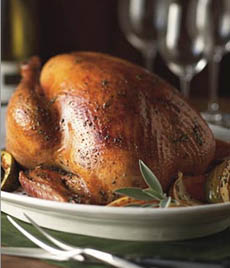

Keep your meat juicy during the cooking process by brining it first. Photo courtesy Butterball.
|
BERNADETTE MARCINIAK is an editorial intern at THE NIBBLE.
|
|
December 2009
|
 |
Brining: It’s Not Just For Turkey!
Many Meats Can Benefit From Brining
CAPSULE REPORT: What once used to be a method of preservation and sterilization for food has now become a great trick to make meat juicy and flavorful, and prevent it from drying out during the cooking process.
Whether you’re preparing a big bird for the holidays, or want to add some zest to a plain dish, brining can help in more ways than one. This is Page 1 of a two-page article. Click on the black link below to visit Page 2.
Overview
Brining is a process that traps water molecules in the cells of your meat’s tissue, and releases said “excess” moisture during cooking. This precludes the risk of dehydration and also reduces cooking time. In addition, it marinates the meat in the liquids and herbs included in the brining solution, therefore making the dish more flavorful when it comes out of the oven (or grill or pan).
In this scenario, by putting your meat in a saline solution, the cells in the muscle tissue of your meat get even more salt from the process of osmosis than they already have. The cells then retain that moisture under heavy heat when cooked via the process of denaturation.
In more basic terms, the cells in meat already have salt, but the brining solution has even more. It leaks through the cell’s semi-permeable membrane. The salt then helps the water latch on to the cells, which swell with a surplus of water. With high heat, these cells burst, releasing all the water into the meat, making it plump and juicy for your taste buds.
Types Of Meat You Can Brine
Brining has most recently become a popular practice for Thanksgiving turkeys as the birds are big, need more time to cook and, therefore, are more prone to drying out. (If you want to know more about turkeys, read our History Of The Turkey.) However, brining benefits many types of meats that are lean and don’t have too much flavor in the tissue already.
In addition to turkeys, hens and chickens can be brined in whole or by parts. Hens can also be brined in a butterfly state. (Find other ways to cook poultry in our Gourmet Poultry Section.) Pork loins, tenderloins, chops and fresh ham (we found our favorite hams) are great candidates for brining before cooking. Shrimp is the best seafood for brining, as the brine actually helps firm the shrimp meat that could otherwise turn out too soft when overcooked. Salmon should only be brined when grill-roasted on a whole side so that it can be in the heat longer and pick up its intended barbecued smoky flavor.
Meats that already have a lot of fat, such as duck, don’t benefit from brining, as the fat already keeps the meat moist and flavorful. Most beef and lamb also are not great contenders for brining, as they tend to be cooked to rare or medium-rare doneness, and never lose the juiciness in the first place. (Read more about the different types of meat in our Gourmet Meat & Poultry Section.)
Continue To Page 2: How To Brine
Go To The Article Index Above
Lifestyle Direct, Inc. All rights reserved. Images are the copyright of their respective owners.

|




